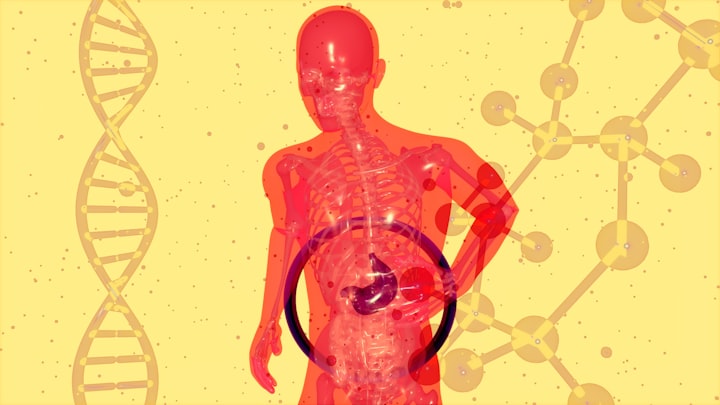Your Liver is dying!
12 Weird Signs of Liver Damage

In this article, we are going to discuss some early signs that might indicate liver damage. Knowing these signs can be crucial as it can allow you to take proactive steps to stop its progression from getting worse, as the liver has the ability to heal itself if taken care of properly. According to statistics from the American Liver Foundation, 25% of adults in the USA are affected by liver disease. Despite what people think, excessive alcohol consumption isn't the only cause of liver damage. There are other factors that can also lead to liver damage, such as eating processed foods, consuming too much sugar and vegetable oils, taking too many painkillers, and viruses can also cause damage to the liver. So, if you would like to know if there are any problems with your liver, watch this video through to the end as we will also discuss some natural home treatments to clean the liver and prevent further damage.
1. Pale Stool: Pale stool can be a sign of liver damage. When we eat food, our liver produces bile to digest foods and fats in it. This gives the stool its normal brown color. But when you have a damaged or fatty liver, it can hinder the flow of bile through the bile ducts. This changes the color of the stool, making it lighter, paler, or clay-colored due to the indigestion of fats. Your stools can become buoyant, causing them to float on the surface of toilet water. So, do not ignore these signs and consult a medical professional as soon as possible.
2. Nyctalopia: Poor night vision or nyctalopia can be another sign of damaged liver. It is a condition where an individual has difficulty seeing in low light or darkness. As we know, the liver's duty is to filter toxins and produce proteins, including one called retinol-binding protein that transports vitamin A to the retina. When the liver is damaged, it can lead to a deficiency of vitamin A, which affects the cells and the retina responsible for low light vision. If experiencing poor night vision, it is important to see a doctor as it may indicate liver damage.
3. Swollen Right Foot: Liver damage can lead to a condition called peripheral edema, which is the swelling of tissues, usually in the legs and feet. When the liver is damaged, it may fail to produce enough albumin, a protein responsible for maintaining fluid balance in the body. This imbalance can cause fluid to accumulate in the lower extremities, leading to swollen feet, particularly on the right side due to the way blood flows through the body.
4. White or Yellow Bumps Around the Eyelids: Another weird sign of liver damage is when you start seeing white or yellowish growths around your eyelids. These little packets or bumps around the eyelids are cholesterol deposits known as xanthelasma. When someone has a liver condition, the liver stops breaking down cholesterol; instead, it starts building up in different parts of the body, including the eyelids. Xanthelasma could be a sign of liver disease, so please don't ignore it and have a liver checkup as soon as possible.
5. Right-Sided Pressure: Another noteworthy sign indicating potential liver disease is the sensation of pressure or discomfort on the right side of the rib cage, especially after eating. Basically, the bile produced by your liver becomes thick and sludgy due to liver damage, which then blocks the small ducts connecting to your gallbladder. This sludge buildup puts pressure on your ribs and can even affect your phrenic nerve, causing muscle tightness and discomfort in your right shoulder. It's important to recognize these sensations as possible signs of liver problems so that you can seek help before it's too late.
6. Purple or Red Bumps on Skin: According to medical science, a damaged liver is not able to produce proteins such as fibrinogen, which is a key component of the coagulation cascade, important for blood clotting. This means that you can bruise easily and more often, which can result in unusual purple and red spots or bumps appearing as a rash on the skin. These are mostly observed around the lower legs and arms. Sometimes, they are caused by poor blood circulation, which is also a sign of liver disease.
7. Cracked Heels: Cracked heels can be a sign of a damaged liver. Our body uses vitamin B3, also known as niacin, to keep our skin moisturized, smooth, and strong in order to protect it from damage. However, when our liver is damaged, it uses up all the stored vitamin B3 in an attempt to repair itself. This deficiency of vitamin B3 leads to cracking of the feet, heels, and foot soles. Do not ignore this small sign as it could indicate a damaged liver.
8. White or Swollen Nails: White or swollen nails could indicate serious liver damage or an underlying health issue that affects the oxygen supply to the nails. A study conducted in the 1950s revealed that eight out of ten individuals with severe liver scarring had completely white nails, demonstrating a strong correlation between nail appearance and liver health. Clubbed nails, characterized by round and enlarged fingertips, may also be a sign of chronic hypoxia often associated with liver diseases such as cirrhosis. Monitoring changes in nail appearance along with other symptoms can help in the early detection of liver problems.
9. Dark Urine: If the color of the urine is dark yellow or brown, it is a symptom that our liver may be damaged. The liver plays a vital role in filtering and processing waste products from the blood, including bilirubin, a yellow pigment that gives urine its color. When the liver is damaged, it may not be able to filter bilirubin properly, causing it to build up in the body and giving urine a darker color. This can be a sign of various liver conditions such as hepatitis, cirrhosis, or liver cancer.
10. Jaundice: Jaundice is a significant symptom of a fatty liver. Jaundice occurs when there is an excessive buildup of bilirubin, a yellow pigment produced during the breakdown of red blood cells, in the bloodstream. In a healthy liver, bilirubin is efficiently processed and excreted. However, when the liver is compromised by fat accumulation, its ability to process bilirubin is impaired, leading to its accumulation in the body. This buildup causes yellowing of the skin, eyes, and mucous membranes, giving rise to the characteristic symptom of jaundice.
11. Spider Veins: Spider veins, also known as telangiectasias, are small dilated blood vessels that appear close to the surface of the skin. They often form a web-like network of red, blue, or purple lines, hence the name spider veins. These veins are commonly found on the face, legs, and feet and may indicate an underlying liver condition. When the liver is damaged, estrogen levels are elevated, which can result in increased pressure in the veins, causing them to become visible. Spider veins can also be a sign of other liver conditions such as cirrhosis or hepatitis.
12. Itchy Skin: Itchy skin is a common symptom of liver damage. This condition is caused by a buildup of bile acids under the skin because the liver is not filtering them out properly. This causes histamines to build up in the blood, causing the itchy reaction. This can lead to dry, flaky skin, which can also contribute to the itching sensation. If you have any of these symptoms that we have mentioned above, you might want to visit your doctor and get your liver examined via an ultrasound test to see if you have a damaged liver.
How can we reverse liver damage? Liver damage occurs in four stages. At first, excess fat builds up in the liver cells, leading to inflammation and the development of scar tissue called fibrosis. If not stopped at this stage, it can lead to permanent scarring of the liver, also known as cirrhosis, which is the most dangerous stage and results in liver failure. Fortunately, the liver has the ability to completely heal and regenerate itself with proper diet and other remedies. So, let's delve into the most important steps you can take to heal your liver.
Step 1: Start drinking organic coffee in the morning and instead of adding sugar, add half a teaspoon of turmeric in it. Phytonutrients in turmeric and polyphenols in coffee help reduce scar tissue formation and repair damage caused by drugs, alcohol, and fructose.
Step 2: Drinking at least one liter of water daily can help thin out the blood and aid the liver in producing bile to break down fatty deposits.
Step 3: Incorporate as many liver cleansing herbs and spices into your diet as possible, such as ginger, turmeric, cinnamon, dandelion root, milk thistle, reishi mushrooms, green tea, and cloves.
Step 4: Eliminate inflammatory seed oils from your diet and replace them with anti-inflammatory fats like butter, tallow, extra virgin olive oil, and coconut oil.
Step 5: Incorporate sulfur-rich foods into your diet, such as leafy greens, arugula, radishes, garlic, broccoli, Brussels sprouts, kale, cabbage, mushrooms, pasteurized eggs, oily fish, walnuts, onions, scallions, and broccoli sprouts.
Step 6: Stop eating processed and sugary foods, including bread, biscuits, sweets, ketchup, pancakes, pasta, soda drinks, etc.
Step 7: Consider taking purified bile supplements or digestive enzymes containing ox bile to lower inflammation and cleanse fatty deposits inside the liver.
Step 8: Try intermittent fasting to give your liver a break and keep it healthy.
By following these steps, you can support your liver's natural healing process and potentially reverse liver damage. Consulting with a healthcare professional can help determine the most appropriate approach for your individual liver health needs.
About the Creator
Enjoyed the story? Support the Creator.
Subscribe for free to receive all their stories in your feed. You could also pledge your support or give them a one-off tip, letting them know you appreciate their work.





Comments
There are no comments for this story
Be the first to respond and start the conversation.